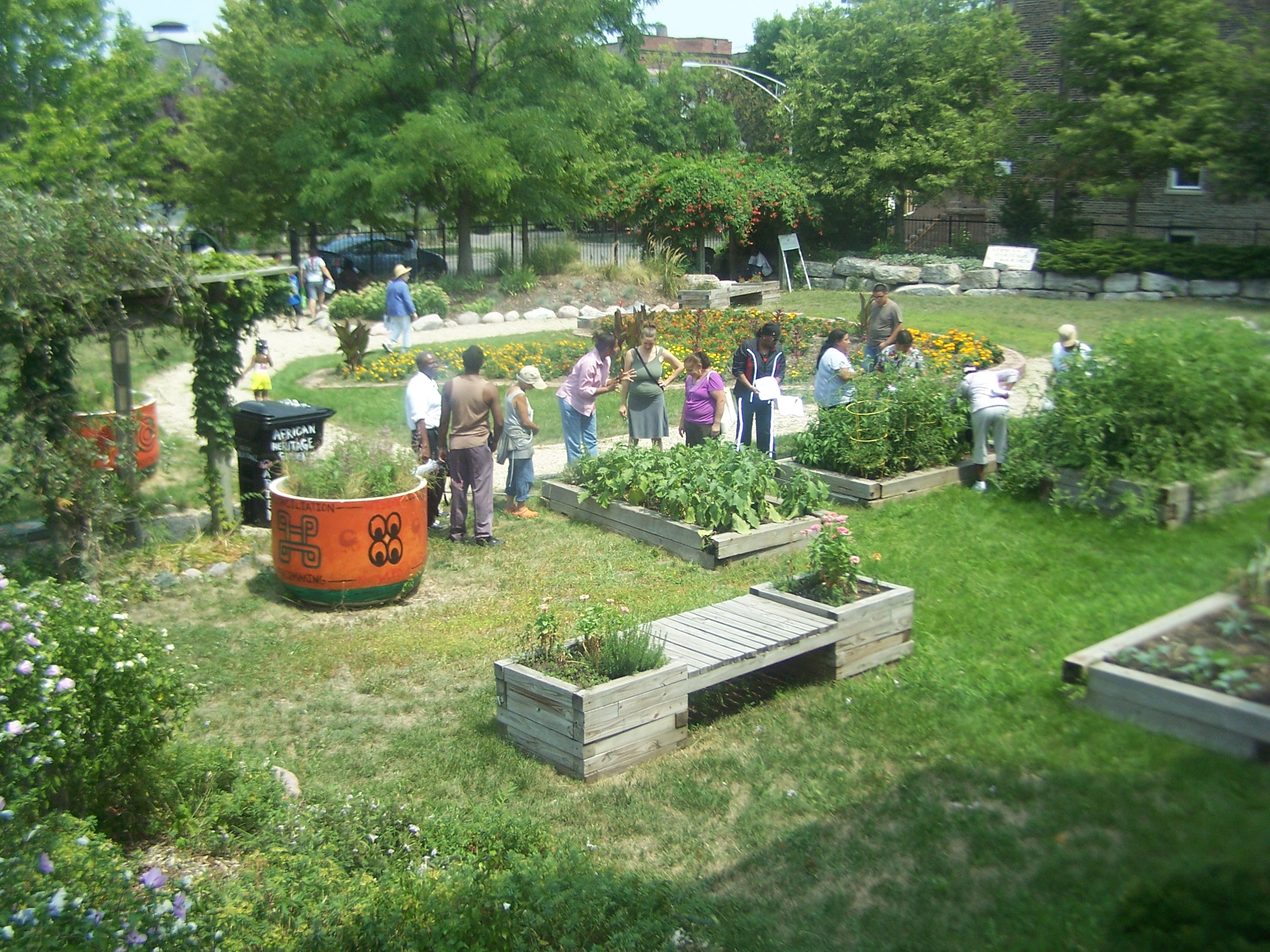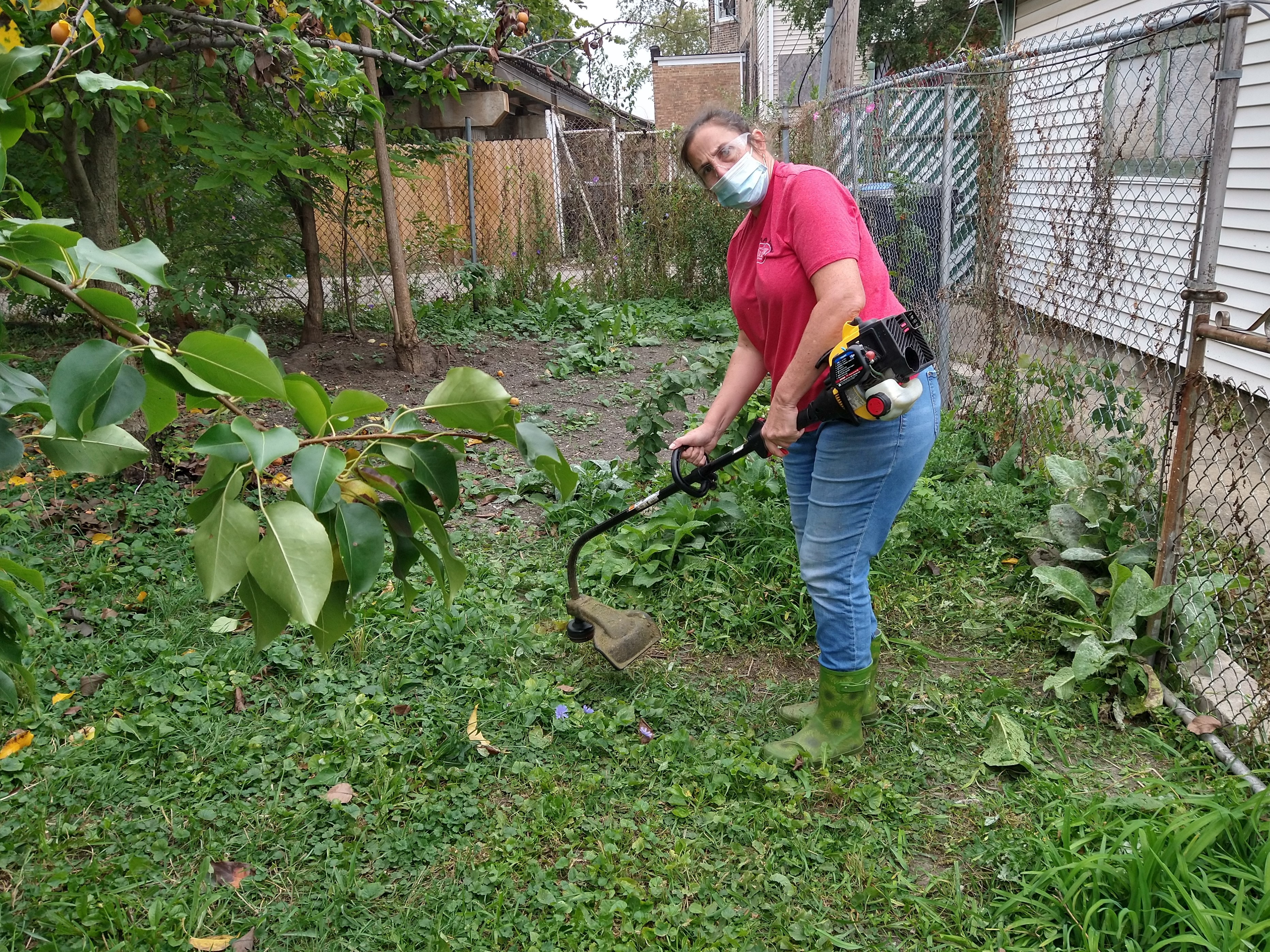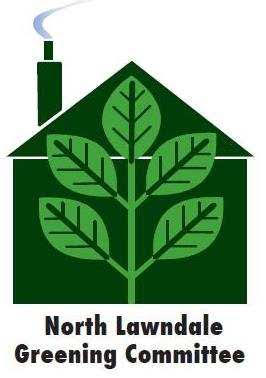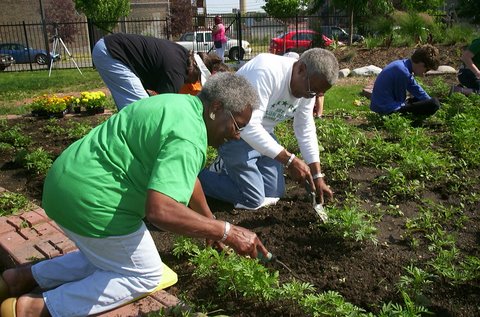Volunteer at this Garden
African Heritage Garden

1245 South Central Park Avenue
The twenty-two year old African Heritage Garden is located on a parcel combined of four city lots at the corner of South Central Park Avenue and 12th Place in North Lawndale. The spacious community garden has a large flower bed in the center, formed into the shape of the African continent with landscaping bricks. The bright yellow and orange flowers are reminiscent of the bold colors in traditional African clothing, as can be seen in the photo above. Large planters on the site are also painted with African motifs and bold colors, and benches offer visitors a place to rest and enjoy the scenery.
The garden has flower beds, trees, and shrubbery along three edges of the space, and raised vegetable plots along the fourth wall. The African Heritage Garden features a wooden trellis for climbing vines and plants. A variety of vegetables are grown in this garden, including sweet peppers, tomatoes, sweet potatoes, swiss chard, and collard greens.
The plants in this garden were started during cold weather in Christy Webber’s Greenhouse. The Fulton Street Flower and Vegetable Garden has offered the North Lawndale Greening Committee space to seed their plants and grow them during the winter months.
The African Heritage Garden was developed under the guidance of the North Lawndale Small Grants Human Development Corporation, with the combined block club (12th Place and Central Park), many North Lawndale Greening Committee members and volunteers participating in its upkeep.
Crystal’s Peace Garden

The residents of the block started Crystal’s Peace Garden in 1997. This garden won 1St place in the City’s Landscape competition. This garden has a wide variety of perennials, annuals, roses and a wide variety of vegetables. This garden has been successful with the regular support of Openlands Project, Green Corp and Ellen Newcomer. Our Garden continues to grow and add to our block.
Garden of Peace, Hope, and Love
This garden was created in July, 2007. We were tired of seeing a lot filled with rubbish and so we decided to start a garden. An eye sore was transformed into an oasis of beauty and peace where neighbors can come and get acquainted with each other.

Green Youth Farm
This Garden was created by Neighborhood Housing Services of Chicago Inc. and Chicago Botanic Garden and is maintained by students from Manley and Lawndale College Preparatory High Schools. This garden has wide variety of vegetables and fruit trees.

Millennium Neighborhoods Garden & Fillmore Apiary
3740 West Fillmore
The Millennium Neighborhood Garden was born in 2005 after the North Lawndale Millennium Team implemented an eight week “healthy eating and physical activity” progra m with 24 community families. The garden was created with the idea that local families can be more self-sustaining while enjoying locally grown healthy food. The garden has a variety of vegetables grown without pesticides and herbicides. We share our space with Mr. Charles Banks, Michael Thompson, and several other gardeners as well as the Chicago Honey Coop’s Fillmore Apiary.
The Fillmore Apiary, called the “bee farm,” was conceived of and created by three passionate urban beekeepers. It provides raw honey from chemical free bee hives, beeswax candles, honey mustard, and three personal care products.
This is a large vegetable garden located on Fillmore Street, just south of a set of unused CSX railroad tracks, on a parcel of land that served as a trucking area for the original SearsTower and distribution center. The land is currently owned by a private developer who has agreed to let the Chicago Honey Coop, North Lawndale Greening Committee, and the Center for Health Promotion and Enhancement use the space for a community garden and Apiary until development moves forward on the site. The developer notifies NLGC each year about whether the groups will continue to have access to the space for another growing season. The garden has been cultivated since 2005, and consists of one large area used by NLGC and other smaller plots used by other community groups and individuals.
The growing areas are raised with at least 18 inches of soil above the still-existing concrete. The soil has been acquired through grants from the Illinois Department of Public Health and Sinai Community Institute, with over 20 cubic yards added to the site the first year and an additional 3 cubic yards, brought in for the 2008 growing season.
TheMillennium NeighborhoodGarden receives fertilizer in the form of horse manure from a local farmer via its partnership with the Chicago Honey Coop. The group also does some composting of leaves, yard waste, and other natural materials on site. With additional soil and a permanent site, the North Lawndale Greening Committee would like to build permanent raised beds.
A wide variety of vegetables are grown on this site, including corn, okra, various squashes, eggplant, tomatoes, hot and sweet peppers, cabbage, collard greens, kale, swiss chard, spinach, turnips, sweet potatoes, white potatoes, broccoli, kohlrabi, beets, garlic, onions, leeks, cucumbers, and a variety of herbs. Sunflowers are scattered in groups throughout the site, and a plastic Santa Claus acts as a scarecrow.
The North Lawndale Greening Committee grew produce well into fall for the first time in 2008, employing light cloth ground covers that protected lettuces, spinach, and turnips from temperatures as low as 24°F. The committee looks forward to the day when it is able to grow year round inside a greenhouse. Adjacent to the vegetable plots are a number of beehives tended by the Chicago Honey Coop.
Sweet potatoes and butternut squash are two of the largest crops harvested from the site. In 2007, the Millennium Neighborhood Garden and the Chicago Honey Coop harvested over 300 pounds of sweet potatoes, and expects to grow even more this year. One hundred pounds of the crop was sold to a farmer for $2 per pound, and bushels of sweet potatoes averaging 20 pounds are sold to community members for $15. Community residents could also stop by for 3 – 4 pounds of potatoes for free. Sweet potato slips are grown in the Garfield Park Conservatory greenhouse and continued on site, so the amount of sweet potatoes harvested is limited only by the growing season.
The vegetables are grown without the use of herbicides, pesticides, sewarge sludge, and chemical fertilizers, though the site is not certified as organic. The garden has seen some problems with insects and rabbits, so the group has adopted natural methods of keeping pests away, spraying a hot pepper concoction, employing crop rotation, using combination planting, and spraying essential oils on the leaves of plants in danger.
Most of the produce grown on the site is either consumed by the volunteers who tend the garden or by community members who are given fresh produce during community tours. Members of the Greening Committee boast rightfully that they haven’t bought greens or other vegetables in years.
Dr. Shemuel Israel, Charles Banks, and Michael Thompson are the primary caretakers of the site, though other gardeners from the North Lawndale Greening Committee participate in growing vegetables. Approximately 250 volunteers have contributed their effort to the gardens over the past four years. In addition to North Lawndale Greening Committee members and community residents, the North Lawndale Youth Garden Corp, Chicago Cares volunteers, Chicago Honey Coop volunteers, and “DOOR” volunteers (Discovering Opportunities for Outreach and Reflection) have been involved in preparing the beds, and planting, caring for, and harvesting the vegetables.

Slum Busters Garden
This community garden predates the North Lawndale Greening Committee, having been created in 1986 by Gerald and Lorean Earles. The Earles' focus was to get rid of "the beast" and to bring beauty back to Chicago's blighted neighborhoods. Their community garden won the President's Points of Light Award in 1993.The Slumbusters were one of 4,000 groups nominated and only one of 30 groups who received awards. They received their award from President Clinton at a White House ceremony.
Also in 1993, the Slumbusters garden was featured in the movie, "To Sir with Love Part 2" with Sidney Poitier. They still have two of the three evergreen bushes that were planted in the garden for this movie.
This garden also provided the impetus for the Slumbusters to get involved in other neighborhood projects such as the redevelopment and renovation of nearby Douglas Park. Today, although the Earles are deceased, they continue to inspire others through their example to get rid of "the beast" and beautify their neighborhoods.
This large garden, located underneath and adjacent to the Pink Line elevated train tracks, features flowers, vegetable plots, and various hand-painted signs declaring “Slumbusters” and “To Do Nothing is To Be Nothing”. The Slumbusters garden is composed of a city-owned lot and land under the train tracks, which is owned by the Chicago Transit Authority.
Gerald and Lorean Earles not only created the Slumbusters Garden, they have a another community garden at 1944 S. Trumbull on the other side of two adjacent greystones. This second garden contains only flowers, though a small glass greenhouse is used to start sensitive plants in the spring, and benches are lined with vegetable seedlings for use in the main garden.
Why do we like to garden? "We like to eat fresh vegetables. It makes the community safer, it makes the community beautiful, people stop and look at the garden, people riding the train enjoy looking down on the garden and it’s a good excuse for Earl and myself."
A wide variety of vegetables are grown in this garden, including a range of cooking greens, tomatoes, peas, beans, squashes, peppers, cucumbers, onions, and herbs. The vegetables are primarily grown for the consumption by those who tend the garden, though extra produce is at times given away to community residents.


